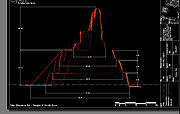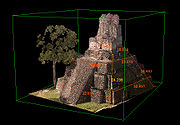
CyArk
Encyclopedia

CyArk’s founder, Ben Kacyra, stated during his speech at the 2011 TED Conference that the organization was created in response to increasing human and natural threats to heritage sites, and to ensure the “collective human memory” is not lost while making it available through modern dissemination tools like the internet and mobile platforms.
History

3D scanner
A 3D scanner is a device that analyzes a real-world object or environment to collect data on its shape and possibly its appearance . The collected data can then be used to construct digital, three dimensional models....
(called the Cyrax
Cyrax (HDS system)
Cyrax is a line of High Definition Survey systems. They are portable scanning systems mostly based on time-of-flight technology. Civil engineers Ben Kacyra and Jerry Dimsdale invented and patented the technology in 1998 ....
) designed for surveying purposes during the 1990s. After Kayra’s company (Cyra Technologies) and all rights to the invention were purchased by Swiss firm Leica Geosystems
Leica Geosystems
Leica Geosystems based in eastern Switzerland produces products and systems for surveying and geographical measurement...
in 2001, Kacyra dedicated his energy to the application of the new technology to the documentation of archaeological and cultural heritage resources through CyArk. CyArk’s primary focus has been the documentation and digital preservation of threatened ancient and historical architecture found at sites such as Colorado's Mesa Verde, Italy's Pompeii
Pompeii
The city of Pompeii is a partially buried Roman town-city near modern Naples in the Italian region of Campania, in the territory of the comune of Pompei. Along with Herculaneum, Pompeii was destroyed and completely buried during a long catastrophic eruption of the volcano Mount Vesuvius spanning...
, Wyoming’s Fort Laramie, and Kacyra's native Mosul
Mosul
Mosul , is a city in northern Iraq and the capital of the Ninawa Governorate, some northwest of Baghdad. The original city stands on the west bank of the Tigris River, opposite the ancient Assyrian city of Nineveh on the east bank, but the metropolitan area has now grown to encompass substantial...
in Iraq – also known as the biblical Assyrian
Assyrian
-In antiquity:*ancient Assyria**the Old Assyrian period **the Middle Assyrian period **the Neo-Assyrian period *Either of two provinces of the Persian Empire:**Achaemenid Assyria...
city of Nineveh
Nineveh
Nineveh was an ancient Assyrian city on the eastern bank of the Tigris River, and capital of the Neo Assyrian Empire. Its ruins are across the river from the modern-day major city of Mosul, in the Ninawa Governorate of Iraq....
.
CyArk has generated a fairly large amount of publicity since its inception. Initially, this was in part due to the relevance of Kacyra's life story to the ongoing Iraq War, during which much of the country's cultural patrimony was destroyed amidst a spasm of looting
Archaeological looting in Iraq
Since the 2003 invasion of Iraq, archaeological looting has become a major problem. Though some sites, such as Ur and Nippur, are officially protected by US and Coalition forces, most are not...
and heavy military damage to important historical sites such as Babylon
Babylon
Babylon was an Akkadian city-state of ancient Mesopotamia, the remains of which are found in present-day Al Hillah, Babil Province, Iraq, about 85 kilometers south of Baghdad...
and Samarra
Samarra
Sāmarrā is a city in Iraq. It stands on the east bank of the Tigris in the Salah ad-Din Governorate, north of Baghdad and, in 2003, had an estimated population of 348,700....
. In recent years, however, Kacyra has taken on more of an advisory role while the independent CyArk organization has gathered considerable momentum as a major entity in the historic preservationist and cultural resource/heritage management communities. Ben Kacyra still remains as the organization’s primary public face, and he is a popular speaker at conferences such as Google’s Zeitgeist (2008), and TEDGlobal (2011), generally discussing his life story and the potential of digital preservation to save the “collective treasure” of global heritage.
Project Focus

Kasubi Tombs
The Kasubi Tombs in Kampala, Uganda, is the site of the burial grounds for four kabakas , and a UNESCO World Heritage Site.On 16 March 2010, some of the major buildings there were almost completely destroyed by a fire, the cause of which is under investigation...
, Uganda
Uganda
Uganda , officially the Republic of Uganda, is a landlocked country in East Africa. Uganda is also known as the "Pearl of Africa". It is bordered on the east by Kenya, on the north by South Sudan, on the west by the Democratic Republic of the Congo, on the southwest by Rwanda, and on the south by...
. As noted in National Geographic Magazine (Dec. 2011), the Kasubi Tombs were digitally preserved by CyArk before their demise, providing a lasting digital record and potential blueprint for reconstruction effort.
CyArk’s publicly-accessible web archive focuses on each archaeological site studied with a short film introduction, a slideshow of site history and the digital preservation process carried out, a site plan, geo-located multimedia on the plan (also accessible in an image gallery), three-dimensional images of site details such as rooms and profiles (often taken from a "point cloud
Point cloud
A point cloud is a set of vertices in a three-dimensional coordinate system. These vertices are usually defined by X, Y, and Z coordinates, and typically are intended to be representative of the external surface of an object....
" image showing the raw scan data), and computer-generated reconstructions. Befitting the public educational aspect of their mission, CyArk has granted permission for reuse of some of its images through a Creative Commons
Creative Commons
Creative Commons is a non-profit organization headquartered in Mountain View, California, United States devoted to expanding the range of creative works available for others to build upon legally and to share. The organization has released several copyright-licenses known as Creative Commons...
Attribution/Share-Alike license, while the rest are freely accessible through the site.
CyArk’s online mission statement expresses the belief that the dissemination of free digital content about heritage sites will encourage additional visitations by tourists, invigorating communities with cultural tourism related revenue. It further states that youth and educators will benefit from free, publicly-accessible access to historical and site information, including some Creative Commons-licensed content, while the creation of digital records ensures that the sites are never lost forever and allows for the continued mining of information over time as technologies and methods of information extraction evolve.
As of October, 2011, CyArk has posted 28 finished projects on their official website for full public viewing:
- Ancient Merv, a major crossroads along the ancient silk road in Turkmenistan
- Ancient Thebes and the Ramesseum/Necropolis of Ramses II, Egypt
- Angkor Wat’s western causeway and Banteay Kdei areas, Cambodia
- The Bab al-Barqiyya Gate, a portion of the Ayyubid Wall in Cairo, Egypt
- A Carmelite Church in Weissenburg, Germany
- Beauvais Cathedral, a Gothic masterwork in France
- Chavin De Huantar, 3500 year-old capital of the Chavin culture, Peru
- Chichen Itza, ancient Yucatan Maya center and pilgrimage site, Mexico
- Deadwood, the legendary Old West city in South Dakota, United States
- Fort Laramie, historic center of the Plains Indian Wars and the Oregon Trail, United States
- The Hypogeum of the Volumnis, an intact Etruscan tomb near Perugia, Italy
- Mesa Verde’s Spruce Tree House, Square Tower House, and Fire Temple, ancestral Puebloan cliff structures in Colorado, United States
- Monte Alban, the capital of the ancient Zapotecs of Oaxaca, Mexico
- Nineveh, imperial capital of the Assyrian Empire, Iraq
- Piazza Del Duomo’s Baptistery, Cathedral, and Campanile (also known as the Leaning Tower of Pisa), Italy
- Pompeii, ancient Roman city buried under the volcanic eruption of Mt. Vesuvius, Italy. The CyArk website states that this project was also the first time laser scanning was used to document a cultural heritage site.
- The Presidio of San Francisco, a historic military base, United States
- Qal’at al-Bahrain, a 14th century Portuguese fort built atop the remains of the ancient Dilmun civilization’s hilltop capitol, Bahrain
- Rapa Nui (Easter Island), scans of the famous monuments and lesser-known structures of this very-isolated Polynesian culture site, Chile
- Roman Baths of Weissenburg, one of the best-preserved examples of Thermae along the remote borders of the Roman Empire, Germany
- Royal Kasubi Tombs, culturally-vital mausoleum of the last four Bugandan Kings, Uganda. The Tombs were scanned and documented by CyArk in 2009 then largely destroyed by a fire in 2010, and data from the scans will be used for reconstruction efforts.
- Saint Sebald Church, a medieval cathedral in Nuremberg that was heavily damaged during WWII but retained enough original architecture to allow for digital reconstructions, Germany
- Church and Cloister of Saint-Trophime, a former cathedral in Arles that contains some of the world’s most notable Romanesque facades, France
- The Pelourinho of Salvador da Bahia, historic downtown district of Brazil’s original capitol
- Stone Bridge of Regensburg, 800-year old bridge across the Danube, Germany
- Tambo Colorado, an adobe-built strategic center of the ancient Inca empire, Peru
- Tikal, one of the most important and longest-occupied cities of the ancient Maya world, Guatemala
- Tudor Place, a Federal-style neoclassical mansion that served as home to six generations of George Washington’s immediate descendants
The CyArk website also has a section on hazards faced by global heritage (in general), composed of a world map delineating sites at risk from earthquakes as well as sea level rise due to Global Warming
Global warming
Global warming refers to the rising average temperature of Earth's atmosphere and oceans and its projected continuation. In the last 100 years, Earth's average surface temperature increased by about with about two thirds of the increase occurring over just the last three decades...
.
Funding
Although initially fully supported by the Kacyra family and their Kacyra Family Foundation, CyArk is now primarily funded through individual project funding, corporate in-kind support, and foundation grants/donations. CyArk has also established working relationships with numerous project partners in the engineering, media, and academic worlds; including Christofori und Partner, PBS, and UC Berkeley, where the company coordinated an internship program with the department of Anthropology in 2006-2007 and is currently an approved Work Study employer for Cal students. According to updates on the CyArk website, already-existing partnerships with the United States’ National Park ServiceNational Park Service
The National Park Service is the U.S. federal agency that manages all national parks, many national monuments, and other conservation and historical properties with various title designations...
(NPS), the United Kingdom’s Historic Scotland
Historic Scotland
Historic Scotland is an executive agency of the Scottish Government, responsible for historic monuments in Scotland.-Role:As its website states:...
(HS), World Monuments Fund
World Monuments Fund
World Monuments Fund is a private, international, non-profit organization dedicated to the preservation of historic architecture and cultural heritage sites around the world through fieldwork, advocacy, grantmaking, education, and training....
, and Mexico’s Instituto Nacional de Anthropoligia y Historia (INAH) have been greatly expanded as of October 2011, with upcoming projects that include Mexico’s Teotihuacan, Scotland’s Rosslyn Chapel, Iraq’s Babylon
Babylon
Babylon was an Akkadian city-state of ancient Mesopotamia, the remains of which are found in present-day Al Hillah, Babil Province, Iraq, about 85 kilometers south of Baghdad...
, and the U.S.’ Mount Rushmore National Memorial.

